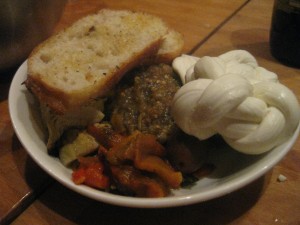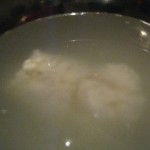Oh, Groupon—how did we ever find cheap and marginally educational weekend recreation without you? The ubiquitous discount site was where I happened upon the mozzarella cheese-making class at BrickNYC, a brick oven pizza joint in downtown Manhattan. And since I have long harbored a secret fantasy in which I own a nanny goat named Moo Goo Gai Pan and make my own fresh chevre, I decided that it was worth a try. Here are my key takeaways:
Cheese details are not for the faint of heart.
People really do not like talking about food and poop in the same sentence, especially if the connection goes beyond the most basic one. My classmates looked a little dismal at the revelation that cheese is basically bacteria poo, except for two lively young women who clearly had had the good sense to pre-party before the class began. When the question of the holes in Swiss cheese was posed to one of them, she gasped and exclaimed, “Oh! Like little farts!”
Pity the piglet.
Apparently, you can make cheese from the milk of any mammal (yes, including humans), but the only one that tastes really vile is pig cheese. I was really curious about this fact, and asked our instructor Patrick to elaborate, but he said I was just supposed to trust him. Boo. Sounds like a cop out to me. Doing a little internet research today, the most prevalent theory is that pig cheese tastes bad because they are omnivores rather than ruminants like cows and sheep. This goes against another fact that Patrick put to us about diet not affecting the taste of the milk but since he gave us some extra curd when Jason answered a trivia question correctly, I guess I’ll forgive him.
We suffered from low expectations.
Actually making cheese from scratch is a tricky business, and involves laying your hands on some hard-to-find ingredients like unpasteurized milk and rennet. It was also deemed too difficult for the likes of us cheese amateurs, so we started from the curd stage, which you can purchase from farmers markets and which makes the process of making mozzarella so easy that a monkey could do it. Or a room full of drunk Groupon patrons. It was still a pretty neat trick, but I would have preferred a little more rigor in my cheese instruction.
I have a stomachache.
Patrick warned us that cheese was both an aphrodisiac and a sedative, but its powers do not end there. I woke up the next morning with a Grade A stomachache and some serious qualms about Patrick’s assertions that even if you drop the curd on the floor, the hot brine will kill off the bacteria. Then again, maybe it’s just not a good idea to eat vast amounts of still-warm cheese and wash it down with half a bottle of red wine. Mea culpa.
Despite my minor gripes, it was not, on the whole, a terrible way to spend a Sunday evening. Cheese-making class is, after all, what you make of it. That’s why Jason’s view of the class might be different from mine; hear all about it tomorrow in the “he said” half of this post…


